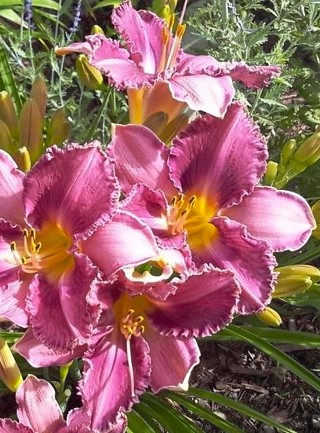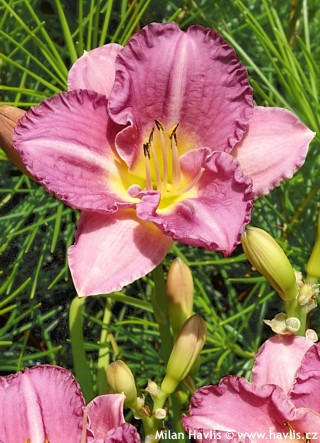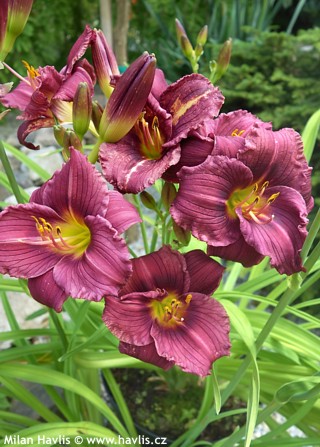
Hemerocallis 'CHICAGO KNOBBY' daylily (tetraploid)
Hemerocallis
Daylilies are flowering queens for one day. Each bloom lasts a day but there is no need to worry – every stem bears more blooms and as the plants grow older they have numerous stems each. This low-maintenance perennial is a miracle for those who have limited time to spend looking after their gardens because apart from occasional watering on hot and dry summer day it needs ABSOLUTELY NOTHING. And still it can leave us gazing at their beautiful, lily-like blooms of every possible colour you can think of (except for blue and black).
Chicago Knobby is a daylily tetraploid (with 4 sets of chromosomes: total 44 in each cell) which was a personal breakthrough in the field of purple colour for Chicago based hybridizer James Marsh, and is still today considered the ultimate purple. The flowers are large, 15 cm across, and combine light and deep purple shades and a yellow throat. They come out from June until July. Stems are 50-60 cm tall and leaves are semi-evergreen.
James E. Marsh (1902-1978) was an American breeder who had tried several plant species before he landed in the field of daylilies in 1955, figuratively of course - he was never a pilot. He loved all colours but his biggest ambition was blue or anything close. He became renowned for his Prairie series of 36 diploid varieties where he introduced his first close-to-lavender achievements of cold rosy pink with violet hues. However, the real breakthrough happened when he began hybridizing tetraploids which opened a whole new world of colours and shapes for him. We was among the first tetraploid-breeding pioneers and his enthusiasm was crowned with an outstanding series of 74 tetraploid daylilies called after his home town Chicago. It was between 1969 until his death in 1978 when his grandson Roy took over and continued with his unfinished work until 1987, releasing the latest varieties under his and Charles Klehm's name who bought James' stock after he died. His wife Searcy along with AHS (American Hemerocallis Society) established a James E. Marsh Award for the best purple or lavender daylily which ran from 1981 to 1990. James himself received the prestigious Bertrand Farr Silver Medal in 1974, an award for outstanding achievements in daylily hybridizing, and will always be remembered for the one who brought true purple to the world of daylilies.
Dailily leaves are deep green, strong and healthy. They appear early in the spring and persist until winter unlike spring bulbs whose leaves wither away after flowering. Apart from occasional slug attack there are no pests or diseases they would suffer from. Put your daylilies in a sunny spot and fertilize it for better flowering every spring, if you want to. It tolerates all types of soil, preferably it likes moist soil. Very hardy to min. -40°C (USDA zone 3).
Last update 11-01-2019





































